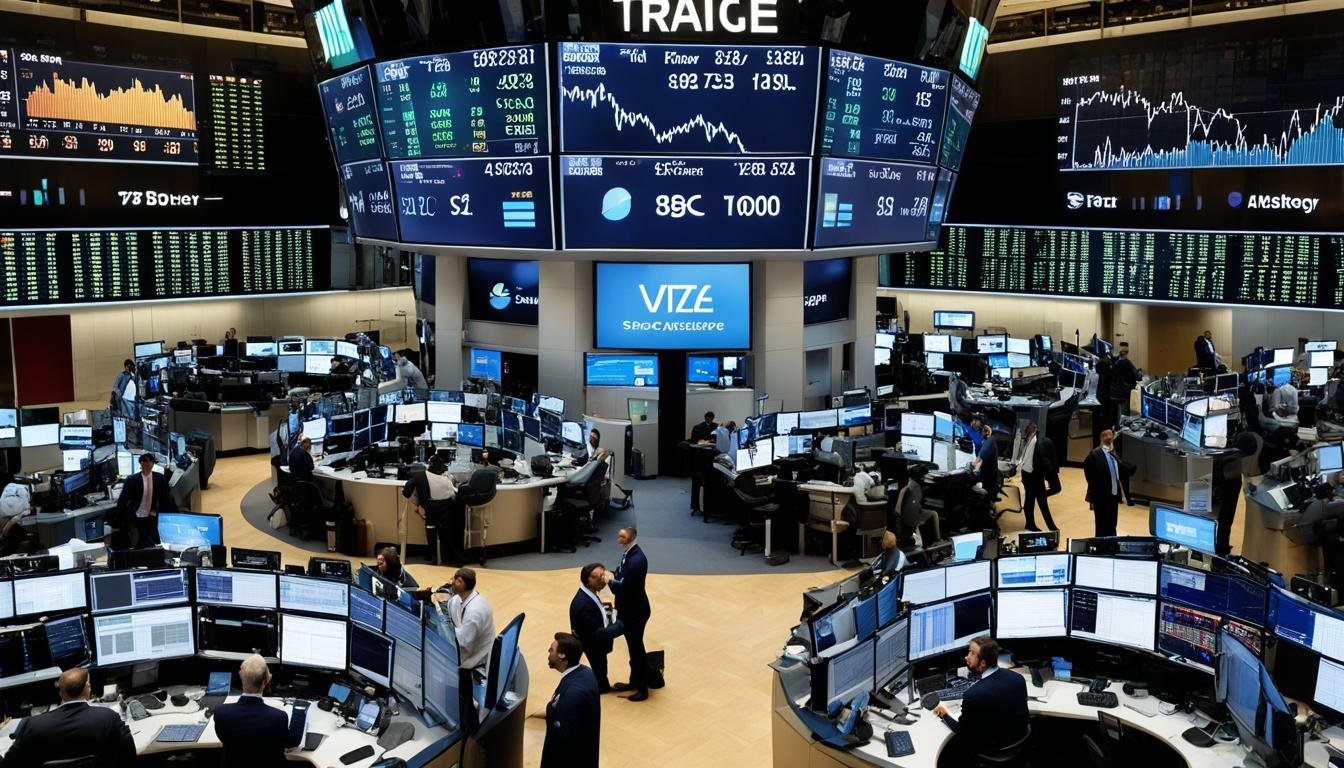Understanding Market Microstructure Essentials
Market microstructure economics focuses on how prices adjust to new information and how the trading mechanism affects asset prices. It is a crucial field of study for traders and investors looking to gain a deeper understanding of financial markets.
Key Takeaways:
- Market microstructure is the study of how financial markets operate and the factors that influence price movements.
- It involves analyzing the structure of exchanges, the price discovery process, liquidity dynamics, and the behavior of market participants.
- Understanding market microstructure helps traders analyze supply and demand dynamics, identify support and resistance levels, and interpret market movements.
- Market participants, such as market makers and market takers, play a crucial role in providing liquidity and influencing market movements.
- Market microstructure principles apply to various market types, including cryptocurrency, forex, and stock markets.
What is Market Microstructure?
Market microstructure is a vital field of study that delves into the intricate workings of financial markets. It examines the structure of exchanges and trading venues, the process of price discovery, the determinants of spreads and quotes, intraday trading behavior, and transaction costs. By analyzing market microstructure, traders gain a comprehensive understanding of the supply and demand dynamics, liquidity levels, and the factors that influence price movements.
Understanding market microstructure is essential for traders and investors seeking to make informed trading decisions. By comprehending the inner mechanisms of markets, individuals can assess and interpret critical information. This enables them to identify trading opportunities, minimize transaction costs, and optimize their investment strategies.
To grasp the significance of market microstructure, let us explore its key components in more detail:
- Trading Mechanism: Market microstructure investigates the functioning and operation of trading mechanisms in financial markets. It examines how orders are matched, executed, and settled, as well as the different types of order placement and execution methods.
- Price Discovery: Market microstructure sheds light on the process of price discovery in financial markets. It explores how prices adjust to new information and the factors that influence supply and demand dynamics, enabling market participants to grasp the drivers behind price movements.
- Liquidity: Liquidity is a fundamental aspect studied in market microstructure. It refers to the ease with which assets can be bought or sold without causing significant price changes. Market microstructure examines liquidity levels and assesses the impact of liquidity on trading costs and price volatility.
Market microstructure uncovers the intricate details of how financial markets operate and provides invaluable insights into the behavior of market participants. By studying market microstructure, traders can gain a competitive edge in the market, effectively manage risks, and make more informed trading decisions.
| Benefits of Studying Market Microstructure |
|---|
|
Obtaining knowledge of market microstructure can empower traders to navigate the complexities of financial markets with greater confidence and precision. By delving into the intricacies of trading mechanisms, price discovery, and liquidity, market participants can gain a deeper understanding of market dynamics.
Exchanges and Price Discovery
Exchanges play a vital role in facilitating the buying and selling of financial securities. They provide a centralized venue where market participants can come together to conduct transactions. By offering a transparent and regulated environment, exchanges ensure fair and efficient trading.
One crucial aspect of market microstructure is price discovery. It refers to the process through which the equilibrium price is determined based on the interplay of supply and demand. Price discovery takes into account various factors, including the level of liquidity, the number of bids and offers, and market participants’ risk appetite.
“The bid and offer prices are key components in the price discovery process.”
Bids and offers represent the maximum price a buyer is willing to pay and the minimum price a seller is willing to sell for, respectively. The difference between the bid and offer is known as the spread. By examining the depth of bids and offers in the market, traders can gauge the level of interest and liquidity for a particular security.
Market participants have different strategies and motivations when placing orders. They can utilize a variety of order types to execute trades. Market orders are executed instantly at the prevailing market price, while limit orders allow traders to specify a desired price at which they are willing to buy or sell. Stop orders, on the other hand, become market orders when a specified price level is reached, helping traders manage their risk.
In summary, exchanges provide a central marketplace for trading financial securities, and price discovery is the mechanism that ensures a fair and efficient equilibrium price. Bids, offers, and spreads play a crucial role in this process, while market participants can utilize different order types to execute their trades.
Liquidity in Financial Markets
When it comes to financial markets, liquidity is a crucial concept that impacts trading dynamics. Liquidity refers to the availability of buying and selling power in the market, and it plays a vital role in determining the ease and cost of executing trades.
Highly liquid markets are characterized by large trading volume and a deep market depth, which means there are a significant number of buyers and sellers willing to transact at any given time. This liquidity allows for quick and sizable trades without significantly impacting the price. On the other hand, illiquid markets have lower trading volumes and can experience greater price volatility.
Market participants include various players who contribute to the liquidity of the market, such as market makers and market takers. Market makers are entities that provide liquidity by continuously maintaining bid and ask prices for a particular security. They are usually institutional investors or specialized firms that ensure there is a continuous flow of trading activity in the market.
Market takers, on the other hand, are investors who respond to the liquidity provided by market makers. They are individuals or institutions looking to buy or sell securities and take advantage of the liquidity available in the market. Market takers help keep prices aligned with fundamentals or technical analysis and provide a necessary price check for market makers.
Understanding liquidity and its dynamics is crucial for traders and investors when making informed trading decisions. The availability of liquidity impacts the ease and speed of executing trades, the bid-ask spread, and the overall price stability in the market.
“Market liquidity allows for efficient execution of trades and contributes to price stability, making it a key consideration for market participants.”
The Role of Market Makers
Market makers play a vital role in maintaining liquidity in the market. They continuously provide bid and ask prices for a particular security, ensuring that there is always a buyer or seller available. Market makers aim to profit from the bid-ask spread – the difference between the price at which they are willing to buy and the price at which they are willing to sell.
By actively participating in the market, market makers provide liquidity to other market participants. They absorb excess supply or demand, which helps stabilize prices and reduces the impact of large buy or sell orders on the market. In exchange for providing liquidity, market makers earn profits from the bid-ask spread and transaction fees.
The Importance of Market Takers
Market takers are essential participants in financial markets. They ensure that there is demand and liquidity in the market, which ultimately contributes to price discovery and efficiency. Market takers provide a necessary price check by executing trades based on their own analysis or investment strategies.
Market takers help align market prices with fundamental values or technical indicators, ensuring that securities are fairly priced. Their buying or selling activities can also provide valuable information to other market participants, contributing to price discovery and market efficiency.
| Market Participant | Role |
|---|---|
| Market Makers | Provide liquidity by maintaining bid and ask prices |
| Market Takers | Respond to market liquidity and contribute to price discovery |
In summary, liquidity is a critical component of financial markets. It determines the ease and cost of executing trades, the bid-ask spread, and overall price stability. Market makers and market takers play essential roles in providing and responding to liquidity. Market makers ensure that there is always a buyer or seller available in the market, while market takers contribute to price discovery and align market prices with fundamental values or technical indicators.
Market Participants and Market Movements
Market movements are driven by the interaction between buyers and sellers, influenced by their respective supply and demand dynamics. It is the collective actions of market participants that shape price fluctuations in the financial markets. Understanding the behavior of these participants is crucial for traders seeking to navigate the complexities of market microstructure.
One influential factor impacting market movements is the phenomenon of herding behavior. Herding occurs when traders react to apparent levels on the chart that draw attention, such as support and resistance levels. This behavior can lead to increased buying or selling activity, causing prices to move in a particular direction.
Another factor that affects market movements is order splitting. Traders who trade with large order sizes may encounter execution issues due to limited liquidity available at the desired price levels. To overcome this, they may split their orders into smaller sizes or probe beyond swing highs and lows, aiming to execute their trades at more favorable prices.
By understanding the dynamics of market participants, including their supply and demand dynamics, herding behavior, and order splitting strategies, traders gain valuable insights into potential price movements. This knowledge can inform their trading decisions and help them take advantage of market opportunities.
Market participants, supply and demand, herding, and order splitting are key elements influencing market movements in the financial markets.
Different Types of Markets and their Movements
Markets can be categorized based on their volume and liquidity. The movements in these markets are influenced by the interplay between volume and liquidity. Let’s explore the different types of markets and how their characteristics impact market movements.
High Volume and Low Liquidity Markets
In high volume and low liquidity markets, price movements can be quite significant and vulnerable to market manipulations. These markets typically have a large number of trades occurring, indicating high trading activity. However, the limited liquidity means that a large order can have a substantial impact on the market. This volatility can attract opportunistic traders who aim to exploit these price movements.
Low Volume and High Liquidity Markets
On the other hand, low volume and high liquidity markets experience prolonged and less volatile movements. These markets have ample liquidity available, allowing for larger trades without substantially affecting prices. This stability can attract long-term investors who seek more predictable price behavior for their investment strategies.
Moderate Movements in Different Market Scenarios
In markets with high volume and high liquidity or low volume and low liquidity, moderate price movements tend to occur. These markets strike a balance between trading activity and available liquidity, resulting in price changes that are neither too extreme nor too stagnant.
Volatility, in large part, is determined by the level of liquidity in a market. Less liquid markets, with limited buying and selling power, are more susceptible to price manipulation and can experience large price swings. Conversely, more liquid markets require significant buying or selling power to make significant moves, which can provide a more stable trading environment.
Understanding the type of market you are trading in can help you anticipate and interpret market movements. Now, let’s take a look at an illustrative table that summarizes the characteristics of different market types:
| Market Type | Volume | Liquidity | Price Movements |
|---|---|---|---|
| High volume and low liquidity | High | Low | Large and volatile |
| Low volume and high liquidity | Low | High | Prolonged and less volatile |
| Moderate movements | High or low | High or low | Moderate |
As seen in the table above, the volume and liquidity characteristics of different markets directly impact their movements. By considering these factors, you can better assess the dynamics of a market and make informed trading decisions.
IMAGE HERE
https://www.youtube.com/watch?v=TIEsLqN7tDg
Understanding Market Movements
Market movements are influenced by various factors, including support and resistance levels, herding behavior, and order splitting. By understanding these dynamics, traders can make more informed trading decisions.
Support and Resistance Levels
Support and resistance levels are price levels at which the market tends to react. Support levels are the price levels at which buying pressure is expected to outweigh selling pressure, causing the price to bounce back up. On the other hand, resistance levels are the price levels at which selling pressure is expected to outweigh buying pressure, causing the price to drop. These levels are significant because they represent historical price points where traders have previously shown interest in buying or selling.
Traders often pay attention to these levels as they can provide important clues about the future direction of the market. When the price approaches a support or resistance level, traders may adjust their positions or enter new trades, anticipating a reversal or breakout.
Herding Behavior
Herding behavior refers to the tendency of traders to follow the crowd and make decisions based on the actions of others. When a significant number of traders observe a support or resistance level being approached, they may place trades based on the expectation that the price will reverse or break through that level. This collective action can intensify the market movement and lead to increased volatility.
“The herd instinct among forecasters makes sheep look like independent thinkers.” – Edgar Fiedler
Order Splitting
Order splitting is a strategy employed by traders who face execution issues when placing large size trades. Instead of executing a single large order, traders split it into smaller orders to ensure execution at more favorable prices. This strategy helps to minimize market impact and maintain a more controlled buying or selling pressure.
Order splitting can also be used by traders to probe support or resistance levels. By placing multiple smaller orders beyond these levels, they can assess the market’s reaction and potentially enter trades at more advantageous prices.
In summary, market movements are influenced by support and resistance levels, herding behavior, and order splitting. Understanding these dynamics can provide valuable insights for traders, helping them make more informed trading decisions.
Who Moves the Markets?
When analyzing market movements, it’s crucial to understand the key players and factors that contribute to these shifts. Contrary to popular belief, market movements are not solely influenced by market makers or manipulative practices. Instead, they are driven by the interaction of market participants based on supply and demand dynamics, as well as the liquidity available in the market.
Market participants, including individual investors, institutional traders, market makers, and other entities, actively engage in buying and selling assets in the market. Their collective actions, driven by various motives such as profit-making or risk management, influence the supply and demand dynamics that ultimately result in market movements.
Supply and demand play a significant role in shaping the direction of markets. When there’s an imbalance between the number of buyers and sellers, this can cause prices to move accordingly. For example, if there is a higher demand for a particular asset compared to the available supply, prices may increase as buyers compete for limited quantities. Conversely, if the selling pressure outweighs buying interest, prices may decline.
“Market movements are influenced by the liquidity available in the market and the imbalance between supply and demand.”
Liquidity is another crucial factor that impacts market movements. In highly liquid markets, there’s a significant volume of buyers and sellers, making it easier to execute trades without significantly impacting prices. On the other hand, illiquid markets, characterized by low trading volumes, may experience greater price volatility as even smaller trades can cause significant price fluctuations.
Understanding the role of market participants, supply and demand dynamics, and liquidity helps traders and investors gain valuable insights into market movements. By analyzing these factors, they can make more informed decisions about when to enter or exit positions, identify potential trends, and assess risks.
Market Microstructure in Different Market Types
Market microstructure principles extend to various market types, including cryptocurrency, forex, and stock markets. The dynamics of market microstructure influence market functioning, price discovery, and trading behavior. However, the liquidity, volume, and order book characteristics may vary across these markets, resulting in different levels of market movements. Understanding how market microstructure principles manifest in different market types is crucial for traders to navigate these markets effectively.
“Market microstructure principles extend to various market types, including cryptocurrency, forex, and stock markets.”
Cryptocurrency Market
In the cryptocurrency market, market microstructure is shaped by the unique characteristics of digital assets. Cryptocurrency markets operate 24/7, allowing for continuous trading. Liquidity in cryptocurrency markets can vary significantly across different coins and tokens, as well as between centralized and decentralized exchanges. Volume and the order book characteristics may also differ, impacting market movements and the execution of trades. Understanding the specific microstructure dynamics of the cryptocurrency market is essential for traders to make informed decisions.
Forex Market
The foreign exchange (forex) market is the largest and most liquid financial market globally. Forex market microstructure revolves around the decentralized nature of currency trading. Liquidity in the forex market is typically high, with significant trading volume and tight spreads due to the presence of numerous market participants, including banks, institutional investors, and retail traders. The order book characteristics and price discovery process in the forex market are influenced by market dynamics such as economic indicators, geopolitical events, and monetary policy decisions.
Stock Market
The stock market is a prominent example of a traditional financial market. Market microstructure phenomena in the stock market are shaped by the trading mechanisms of exchanges and the interplay between different market participants. Liquidity in stock markets varies based on individual stocks, market conditions, and trading volumes. The order book and trading behavior in stock markets are influenced by factors such as company earnings releases, news events, and investor sentiment. Understanding the microstructure of the stock market is essential for traders looking to navigate this complex and dynamic environment.
| Market Type | Liquidity | Volume | Order Book Characteristics |
|---|---|---|---|
| Cryptocurrency | Varies across coins and exchanges | Can be significant but differs by coin | Can differ between centralized and decentralized exchanges |
| Forex | Generally high | High due to significant market participants | Tight spreads, impacted by economic events and policies |
| Stock | Varies by individual stock and market conditions | Varies based on trading volumes | Influenced by news events, company earnings, and sentiment |
Limitations of Market Microstructure
In the realm of market microstructure analysis, it is important to recognize that there are certain limitations inherent in the field. One such limitation is the complexity associated with high-frequency trading.
High-frequency trading involves the use of advanced mathematical models and programming techniques to execute trades at incredibly fast speeds. This level of sophistication requires a deep understanding of quantitative analysis, algorithms, and technology. As a result, high-frequency trading is typically practiced by institutional investors and sophisticated market participants.
While high-frequency trading plays a significant role in shaping market microstructure and has its own distinct dynamics, this article focuses on the broader aspects applicable to retail traders.
By understanding the basic concepts and dynamics of market microstructure, retail traders can gain valuable insights into trading decisions. While they may not have access to the advanced tools and strategies employed by high-frequency traders, a solid understanding of market microstructure can still inform their trading strategies.
It is important to keep in mind that market microstructure analysis is a multifaceted discipline that encompasses various aspects of financial markets. By acknowledging its limitations and focusing on the broader principles, traders can leverage market microstructure to make more informed trading decisions.
Conclusion
Understanding market microstructure is crucial for traders in making informed trading decisions. By delving into the intricacies of exchanges, the process of price discovery, the dynamics of liquidity, and the behavior of market participants, traders can gain a deeper understanding of the underlying factors that drive supply and demand. This knowledge empowers them to analyze market movements more effectively, identify key support and resistance levels, and interpret market trends with greater accuracy.
Market microstructure provides valuable insights into the mechanics of the market, allowing traders to navigate its complexities with confidence. By considering various elements such as the structure of exchanges and trading venues, the interplay between buyers and sellers, and the nuances of liquidity provision, traders can better assess market conditions and tailor their strategies accordingly. Armed with this understanding, traders can make more informed decisions, optimizing their risk-reward profile and enhancing their overall trading performance.
While market microstructure analysis is an essential tool for traders, it is important to acknowledge its limitations. High-frequency trading, for example, adds complexity to the market dynamics, necessitating specialized knowledge and advanced technological capabilities. However, for retail traders, a solid grasp of the foundational concepts of market microstructure can still provide valuable insights and contribute to more effective trading decisions. By embracing the principles of market microstructure, traders can enhance their understanding of the market ecosystem and navigate its complexities with greater success.







